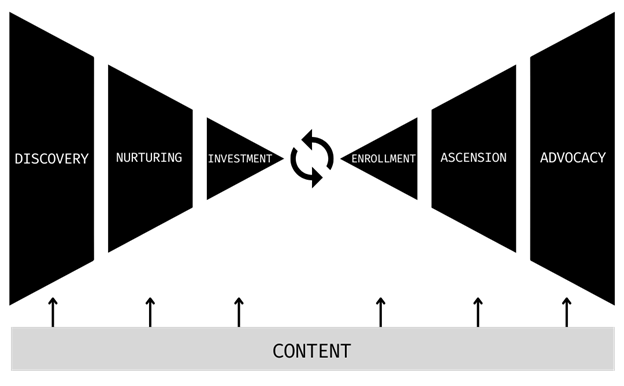The old way of marketing is broken.
Be honest with yourself:
- Are content channels, Web forms, and outreach cadences really performing?
- How many platforms out of all those you're "on" are actually delivering value to your customers, or your company?
- And to what extent are you reliant on new customer acquisition to survive?
The reason those pieces of the puzzle are out of whack is that we're still adhering to outdated principles and obsolete practices that fall miserably short in today's modern marketing ecosystem.
The hard sell, same-old product pushiness, and generic pitches are no longer adequate. The old forceful "funnel" is effectively obsolete. Take it out behind the barn...
The people you want to reach are not straightforward in how they engage. They are erratic, emotional, and nonlinear in their behavior, just like you and me.
I'm proposing a new model for a new era—one that accounts for, even welcomes, erraticism in audience behavior. It's meant to pull, not push. And it's built atop the one thing every single person uses at every stage of their brand interaction: content.
I call this new model the Content Continuum.
What Is the Content Continuum?
The continuum is a six-stage spectrum, not a stagnant funnel, that more accurately guides how the holistic customer experience should work. Again, it's all built atop content-driven experiences.
Instead of the outdated "awareness to purchase" funnel, it moves audiences from "discovery to enrollment to advocacy" in a much more natural flow.
It does that by providing them a curated journey geared to progressively up-level them in their interactions with and commitment to the branded ecosystem.

Within this construct, there are a few implications to note:
- First, new business is not weighted any more heavily than retention, contrary to many marketers' erroneous assumption. All phases are of equal importance.
- Second, the continuum is a pull (not a push) mechanism. Yes, it's geared to convert sales, but with more patience than before. And it's meant to do so by flipping the script: getting people enveloped by and enthralled with our brand before even posing the sale.
- Third, it employs a leveled-access content strategy within the first half: In the discovery phase, it's about using the public domain to get found; but then the focus shifts to building an email list and ushering people into a private VIP content community for more economical nurturing. It also means restricting access to the paid product to an extent: not blasting out CTAs all over the Web, but using a guarded intake process to vet and evaluate people before allowing them access to a video call.
What's interesting about the Content Continuum model, too, is that it allows people to be present in multiple stages simultaneously. I hope my customers are ascending in their status with me while continuing to follow me on social media (discovery). I accept that people who enroll today could be devout advocates tomorrow, especially if they've been mulling on a decision for months, just consuming my 10X content.
Breaking Down the Six Stages of the Content Continuum
Each stage in the Continuum is meant to deliver a tremendous amount of customer surplus or extractable value, above and beyond whatever you, as the business, gleans in return.
Content, in any format, serves as the vehicle through which that value transfer happens most effectively today.
With that, I'm going to break down some of the nuances of each phase.
1. Discovery
I think the most pronounced shift in the first half of the Continuum is a move from using social media primarily as a forum to contact "leads" or "prospects" to using it as a pool for driving membership for a VIP group.
Yes, you want to build a sizable following as well, but the value of a social follower has also gone down the past few years. Now, it's all about private groups.
You still have the three media types—owned, earned, paid—but they have to work together more intricately than ever before. And the formats are changing, too. Earned media, for example, is about getting interviewed on podcasts, doing livestreams with others, and getting featured in their content because your content is that good.
2. Nurturing
Toss out your old prospecting playbook. The new method calls for a much more personalized approach, which, in my mind, can only be accomplished manually.
There are two lanes for prospecting today: within your private group and the usual outbound motion. The difference is that outbound arbitrage techniques are changing so fast, the things that worked two years ago are now obsolete.
The most effective medium, for instance, is SMS. Five years ago, it was probably direct messaging. Or email.
The most effective method, for example, is a self-recorded video and selfie combination (in my experience). A year ago, it was sending a bucket full of social proof via testimonials. But now the market has caught up.
So, your nurturing has to evolve not with, but ahead of, what others are doing. And if you're talking the same way everyone else is, you're getting ignored. So it's about the right approach and right appeal—ideally via warm outreach instead of cold requests for a call. No one's saying "yes" to those anymore, so you need a fresh approach.
3. Investment
The lead-up to a monetary exchange should also be underlined by content experiences.
That approach includes a strategic reversal of the assumed best-practice to close a new deal. Whereas five years ago it was all about getting people on calls to close them live, now it's about giving them everything they need to decide on their own, then using the call as a formality, to make it official.
Loom videos, PDF proposals, and custom-made gifts (audits, opportunity decks) are infinitely more important than having the right call script.
I can disperse a hundred times more PDF audits than I can get calls with "leads." Then, I'll get more calls and more sales than old methods, such as using setters or dropping end-of-article CTAs about new offers.
Mixed that with great pricing and great packaging—moving to a productized model—and you'll make way more sales with a more hands-off approach (allowing people to come to the decision on their own armed with all the content collateral they need to do so) than you will trying to push them along.
4. Enrollment
Enrollment is as much about getting new customers indoctrinated into your belief system as your business.
Fundamentally, this stage is meant to guide new customers toward a second (and ongoing) payment, depending on their package, but you do that through effective onboarding that equips and prepares them for the journey ahead.
There's a structure to do that. It includes a gift of some sort, a physical mailer, and a specific email sequence. It also includes a high-stakes welcome email loaded with easy step-by-step instructions for how to get started.
It's also in this stage where you can set up "customer success insurance" which includes 1:1 check-ins, a group accountability component, and a 24/7 feedback form for customers. All of it content-driven.
5. Ascension
Once they're enrolled and set up for success, your primary order of business must be enhancing stickiness—likelihood to remain and continue to make payments—for customers.
Content can be a powerful accelerant for growing customer lifetime value. In the Content Continuum, there are four pieces to enhancing customer value:
- Adding a continuity offer to enable MRR (monthly recurring revenue)
- Increasing CLTV (customer lifetime value) by creating new opportunities for value exchange
- Building a "customer club" that drives retention
- Reducing churn with cancellation reversals
Each of those invaluable pieces to the customer retention puzzle, once again, is underscored by content.
6. Advocacy
Advocacy is the point at which customers sort of turn a corner. They're not just paying a provider for a service, but they're actively promoting and endorsing the provider.
Another way to think about this stage is that you're scaling word-of-mouth. You're cultivating chatter, then spreading it around the Web.
Three focal areas here are reviews and reputation management, testimonials, and an in-person (or online) mastermind event where you can generate footage of customers in action to then plaster across your media platforms.
Advocacy can also be viewed as the back-end engine that fuels the beginning of the Continuum, effectively leveraging a few loud ambassadors to usher in new customers for you.
Content: The Foundation of Today's Businesses
Content underlies every stage, every component, and every interaction with every person for modern businesses. Content alone can be the foundation of a business, and most great businesses today are built on content—even if they don't realize it.
The opportunity to occupy a leveraged position in your space by putting content at the core is ripe for the taking. In fact, I think the only way to sustainably win the new game of online business, at least for most, is to invest in content.
That means building audience-as-an-asset; constructing an active content hub that exists independently from the products and services you sell; crafting closed communities off the back of that free entry point; then turning the tables once overflowing goodwill has been accrued by enrolling only serious customers into your offers.
Enterprises and empires of tomorrow won't just make content, they'll be made of it.
In my just-released book, CONTENT CAPITALIST, I discuss—at length—the concepts outlined in this article.
More Resources on Marketing Content and the Funnel
Forget the Funnel: Join the Buyer's Journey With Lifecycle Marketing Instead
Have You Filled Your Marketing Funnel?
How to Build a Content Marketing Funnel That Will Drive Sales
Four Tips to Accelerate Sales Through the B2B Content Funnel




